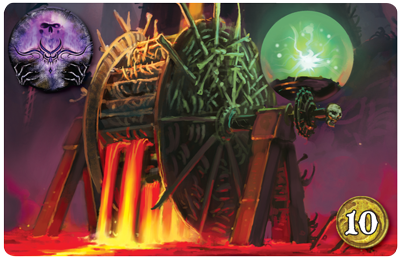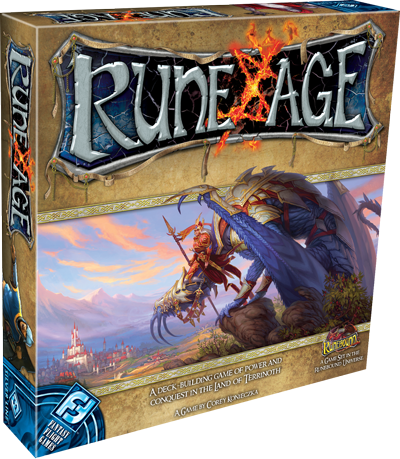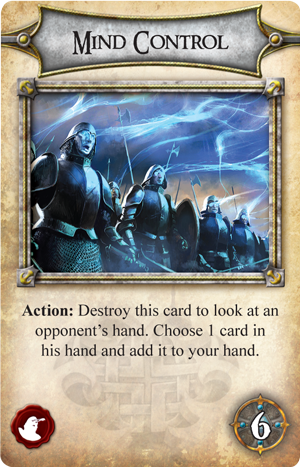FFG, ya nos tiene acostumbrados últimamente a las míni actualizaciones y desde hace algún tiempo nos va ofreciendo en pequeñas píldoras, lo que será su primer DeckBuilder, ambientado en las tierras de Terrinoth, Rune Age.
Como ya he dicho en otras ocasiones, es un juego por el cual tengo interés, la pena es que de momento nadie en estos lares se ha referido a una posible publicación en castellano.
De todas formas, aquí tenéis la actualización de hoy, para que los, que como yo, estéis interesados en el.

In Rune Age, the upcoming card game set in the vibrant fantasy world of Terrinoth, designer Corey Konieczka brings an array of innovations to the deck-building genre. We’ve already seen how scenario-based gameplay delivers varying degrees of player interaction, offering an experience that can be customized depending on your individual tastes. And we’ve even seen how Rune Age can be played as a fully cooperative (or solo) game. Today, we’ll conclude our overview of Rune Age’s four versatile game modes with a look at its fourth, the scenario entitled “The Monument.”
The Monument is designed for players who want a fully competitive game, but who also want to restrict direct player interaction, thereby keeping the focus on their own individual strategies. Mechanically, this amounts to a race to amass a necessary sum of gold, after which victory falls to the first player to spend that wealth erecting a massive tribute to his race’s god or gods. Just as each race has its own distinctive style, each race’s god contributes to its unique flavor. Which deity will you appease?
The Spire of Ruin
 The early Y’llan warlocks raised the Spire of Ruin near the place
where Llovar began his fateful journey into the T’mara T’rusheen, commemorating
the birth of the Uthuk’s demonic powers. The spire was said to bless those whom
flayed themselves upon its sharp stones with visions of greatness. The Spire was
never found or destroyed during the scourging of the wastes, and its location is
now a mystery. As the Uthuk reclaim their home, they search for the Spire, for
the Q’aro Fenn have pronounced its rediscovery a sign of revenge.
The early Y’llan warlocks raised the Spire of Ruin near the place
where Llovar began his fateful journey into the T’mara T’rusheen, commemorating
the birth of the Uthuk’s demonic powers. The spire was said to bless those whom
flayed themselves upon its sharp stones with visions of greatness. The Spire was
never found or destroyed during the scourging of the wastes, and its location is
now a mystery. As the Uthuk reclaim their home, they search for the Spire, for
the Q’aro Fenn have pronounced its rediscovery a sign of revenge.The Statue of Daqan
 Sometimes known as the Last King or the Lost King, King Daqan rose to
rule during the final days of the First Darkness. Over the peaceful years that
followed, Daqan rebuilt his kingdom, but during the Second Darkness he vanished,
never to be seen again.
Sometimes known as the Last King or the Lost King, King Daqan rose to
rule during the final days of the First Darkness. Over the peaceful years that
followed, Daqan rebuilt his kingdom, but during the Second Darkness he vanished,
never to be seen again.He left no heir, and so the Daqan Barons have since ruled in his stead. Some believe that Daqan will return in a time of great need, and so likenesses of the king are common. The Statue of Daqan in Archaut is the greatest such memorial.
The Everliving Engine
 No one knows what the machine does, nor what makes it run, except
that its churning somehow aids the Undying One. Its bony wheels grind in the
volcanic caves beneath the ruins of Kelipa, where it is maintained by the
Archlich Revik. Kelipa is only a few short miles from the edge of the mists.
No one knows what the machine does, nor what makes it run, except
that its churning somehow aids the Undying One. Its bony wheels grind in the
volcanic caves beneath the ruins of Kelipa, where it is maintained by the
Archlich Revik. Kelipa is only a few short miles from the edge of the mists.On particularly quiet nights, when the wind blows in the right direction, the clacking of the Everliving Engine can be heard for miles. The farmers and woodsmen brave enough to live nearby do not sleep easily on those nights…
The Fountain of Purity
 The forests of Latari were once a sanctuary to the pure and
untarnished wildlife cherished by the elves.
The forests of Latari were once a sanctuary to the pure and
untarnished wildlife cherished by the elves.However, the wars for the Dragon Runes have brought unclean invaders into the Aymhelin...
The Fountain of Purity is a spring of mystical water infused with nature’s essence. While its water nourishes the pure of heart, it devours the wicked from within, rejuvenating old beauty and cleansing the forests of the shadow-touched.
A Race to the Finish
As with all Rune Age scenarios, an Objective card indicates the game’s final victory condition – in this case, building a monument that ranges in cost between 10 and 12 gold. This is a seemingly simple matter; each player’s Monument card begins in his Barracks, and by perform a Spend Gold action to put it into play, he achieves victory. The trick, of course, is gaining that much wealth.
Sticking to familiar strategies is a good start, though it will ultimately take more to outwit your opponents. Attack cities to gain their influence, then spend that influence to buy high-value Gold cards. You can even supplement your income by defeating one of the Event deck’s many gold-bearing Enemy cards, like Gata the White Death.
As mentioned above, The Monument is a scenario with relatively less direct player interaction... but that isn’t to say there’s none. On top of the usual tug-of-war over Terrinoth’s many resources, the neutral card Mind Control presents an opportunity to steal gold directly from an opponent’s hand! This, along with a handful of Events that prey directly on your kingdom’s coffers, means that the wealthiest player at the table should develop a healthy degree of paranoia, and that no one is safe until the last brick in his holy monument is placed.
Keep checking back for more on Rune Age, and look for it on store shelves in the third quarter of 2011!





















0 comentarios :
Dí lo que piensas...